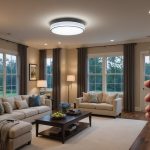Mastering HUD Design in FPS: Key Components for an Engaging User Experience
When it comes to First-Person Shooter (FPS) games, the Heads-Up Display (HUD) is more than just a collection of on-screen elements; it’s a crucial component that enhances the gaming experience, providing players with the information they need to navigate and engage with the game world effectively. In this article, we’ll delve into the key components of HUD design, exploring what makes a HUD exceptional and how game developers can create an immersive and user-friendly interface.
Understanding the Basics of HUD Design
Before we dive into the specifics, it’s essential to understand what a HUD is and its primary functions. A HUD gives players critical information such as health, ammo, crosshairs, and other essential details that help them make informed decisions during gameplay.
Also to see : Unlocking the Secrets of Gesture Magic: Essential Techniques for Captivating AR Game Development
Principles of Good HUD Design
There are several principles that underpin good HUD design, and these are particularly relevant for FPS games:
-
Consistency with Theme and Style: The HUD should blend seamlessly into the game’s theme and style. For example, in the game Dead Space, the HUD is integrated into Isaac’s RIG suit, making it a part of the game world rather than an overlay[1].
In parallel : Designing Realism: Key Ingredients for Developing Authentic Damage Models in Racing Simulators
-
Maximum Clarity and Readability: The information presented should be clear and easy to read. This involves using the right font sizes, colors, and placement to ensure that players can quickly glance at the HUD without being distracted from the gameplay.
-
Smart Placement of HUD Elements: HUD elements should be placed in a way that they do not obstruct the player’s view. For instance, placing health bars at the edges of the screen or using diegetic elements like the ammo counter on the weapon itself can help maintain a clear view of the game world[1].
-
Need to Know Basis: Only display information that is necessary for the player to know at any given moment. This helps in reducing clutter and keeping the player focused on the gameplay.
-
Customizability: Where possible, allow players to customize the HUD to their preferences. This can include adjusting the size, opacity, and position of HUD elements, as seen in Diablo 4[4].
Diegetic vs. Non-Diegetic HUD Elements
One of the most innovative approaches to HUD design is the use of diegetic elements. Diegetic elements are those that are part of the game world itself, rather than being overlaid on the screen.
Diegetic HUD: The Case of Dead Space
Dead Space is often cited as a prime example of effective diegetic HUD design. Here, the health bar is integrated into the back of Isaac’s RIG suit, the ammo counter appears directly on the weapons, and the stasis meter is built into the suit. This design philosophy ensures that all UI elements serve both the player and Isaac within the game’s universe, enhancing immersion and reducing the feeling of being outside the game world[1].
Customization and Usability
Customization is a key aspect of modern HUD design, allowing players to tailor the interface to their preferences and playstyles.
Customizable HUDs in Modern Games
Games like Diablo 4 and Minecraft offer significant customization options for their HUDs. In Diablo 4, players can adjust the size, opacity, and position of various HUD elements such as the minimap, health bars, and ability icons[4].
In Minecraft, mods like Better HUD and MiniHUD allow players to add widgets for coordinates, armor durability, item usage stats, and even real-time clocks or biome indicators. These mods provide a high level of personalization, enabling players to create a HUD that fits their specific needs and preferences[3].
Essential Information and Clutter Management
Managing the amount of information displayed on the screen is crucial for maintaining a clean and usable interface.
Dynamic Design and Clutter Management
A good HUD design should only display information when it is needed. For example, in Dead Space, the HUD elements appear dynamically based on the player’s actions. When aiming a weapon, the crosshair and ammo counter appear, but they disappear when not in use, keeping the screen clean and focused on the gameplay[1].
Real-World Inspirations and Immersion
HUD design can draw inspiration from real-world interfaces and cinematic techniques to enhance immersion.
Cinematic Inspirations
The HUD in Dead Space draws inspiration from cinematic storytelling, where elements like music and visual cues are used both within the story and to engage the audience. This approach makes the HUD feel more integrated into the game world, enhancing the overall gaming experience[1].
Practical Insights and Actionable Advice
For game developers looking to create an engaging and user-friendly HUD, here are some practical insights and actionable advice:
Key Components of an Effective HUD
-
Health and Ammo Indicators: These should be easily visible and updated in real-time.
-
Example: Dead Space integrates health bars into the character’s suit.
-
Example: Diablo 4 allows customization of health bars and ammo indicators[1][4].
-
Minimap and Navigation: A minimap can help players navigate the game world.
-
Example: RuneScape features a customizable minimap with non-customizable sub-buttons[2].
-
Ability and Skill Indicators: These should be clear and easily accessible.
-
Example: Diablo 4 allows players to customize the position and size of ability icons[4].
-
Customization Options: Provide players with options to customize the HUD.
-
Example: Minecraft mods like Better HUD and MiniHUD offer extensive customization options[3].
Table: Comparing HUD Customization in Different Games
| Game | Customization Options | Dynamic HUD Elements |
|---|---|---|
| Dead Space | Limited, but integrated diegetic design | Yes, dynamic elements appear based on actions |
| Diablo 4 | Size, opacity, and position of HUD elements | No, but customizable |
| Minecraft | Extensive, through mods like Better HUD and MiniHUD | Yes, through mods |
| RuneScape | Customizable windows and bars, but limited for core HUD elements | No |
Creating an effective HUD in FPS games is about striking a balance between providing essential information and maintaining a clean, immersive interface. By following the principles of good HUD design, incorporating diegetic elements, and offering customization options, game developers can enhance the gaming experience for players.
As Ben Johnson, a game designer, once noted, “A good HUD is one that you almost don’t notice because it’s so well integrated into the game world.” This philosophy is evident in games like Dead Space, where the HUD becomes an integral part of the player’s experience, rather than an overlay that detracts from it.
In the world of video games, the HUD is more than just a collection of on-screen elements; it’s a gateway to an immersive and engaging user experience. By mastering HUD design, game developers can create games that not only inform but also captivate their players.









